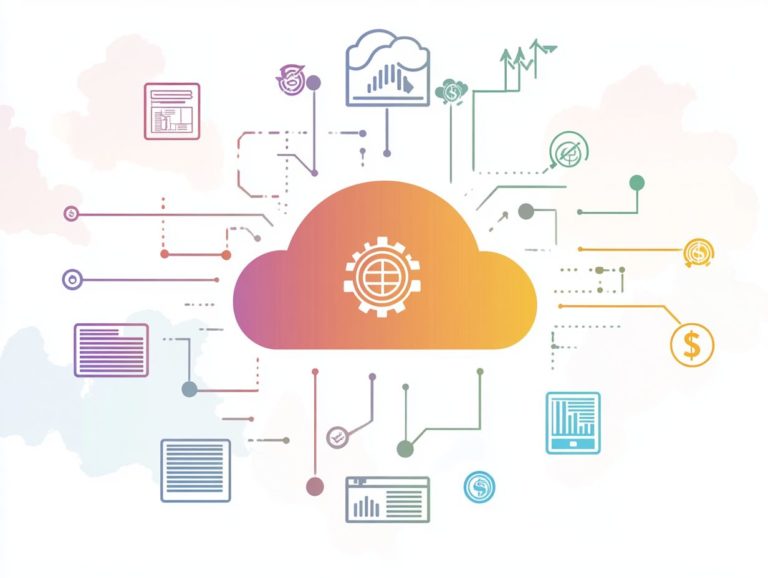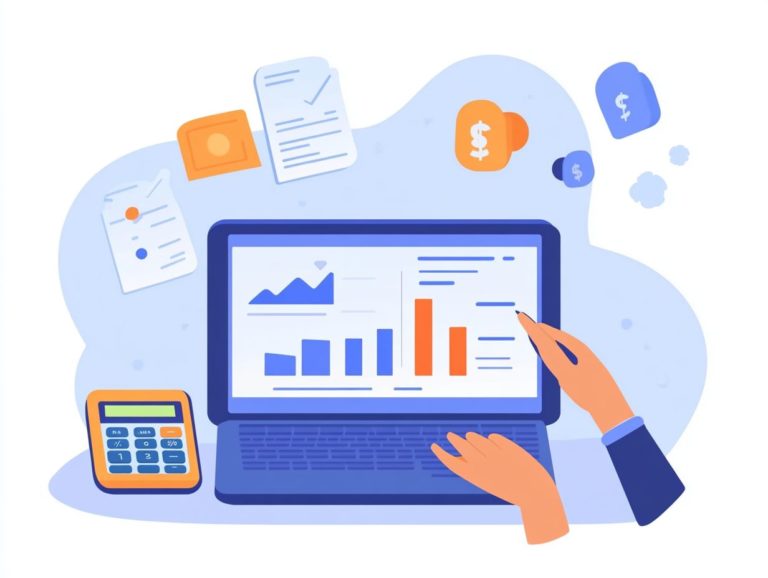Understanding the Cost of Data Transfer in Cloud
In today s digital landscape, grasping the intricacies of data transfer in the cloud is essential for businesses striving to optimize costs and enhance efficiency. Get ready to dive in and discover the nuances of data transfer and its financial implications.
This article delves into what data transfer really means and emphasizes its significance within the realm of cloud computing. You ll explore key factors that influence data transfer costs, discover methods for precise cost estimation, and uncover strategies to trim those expenses.
We ll also discuss how these costs affect the overall pricing of cloud services, empowering you to make informed decisions for your organization.
Contents
- Key Takeaways:
- What is Data Transfer in Cloud?
- Factors Affecting Data Transfer Costs
- Calculating Data Transfer Costs
- Ways to Reduce Data Transfer Costs
- Impact of Data Transfer Costs on Cloud Services
- Frequently Asked Questions
- What is data transfer in cloud computing?
- Why is it important to understand the cost of data transfer in cloud?
- What factors contribute to the cost of data transfer in cloud?
- How can I estimate the cost of data transfer in cloud?
- Are there ways to reduce the cost of data transfer in cloud?
- What are some common mistakes to avoid when it comes to data transfer costs in cloud?
Key Takeaways:

- Data transfer in the cloud refers to the movement of data between cloud services and devices.
- The cost of data transfer is influenced by factors such as bandwidth usage, location, and network infrastructure.
- To cut down on data transfer costs, optimize your strategies and look for alternative options. These costs can also impact the pricing of cloud services and should be considered by customers.
What is Data Transfer in Cloud?
Data transfer in the cloud encompasses the seamless movement of data between various services and locations within a cloud ecosystem, like AWS. This process is vital for cloud services, allowing you to manage your data effectively across different AWS Regions and Availability Zones.
Grasping the intricacies of data transfer is essential for optimizing resource provisioning and controlling costs associated with data coming in and going out. It also ensures that your architecture is well-suited for your workload components.
Defining Data Transfer and its Importance
Understanding data transfer is crucial for your cloud services, especially within AWS, where it plays a vital role in effective data management and optimizing costs. This includes various methods, such as internet transfer, which enables you to move your data across the public internet, often using protocols like FTP or HTTP.
By leveraging CloudFront a service that speeds up the delivery of your websites and applications by caching content at locations closer to your users you can significantly boost performance, thereby reducing latency.
AWS also offers services like S3 Transfer Acceleration, which streamlines your uploads and downloads on a global scale, tapping into Amazon s expansive global network.
For those in need of dedicated connections, AWS Direct Connect enhances bandwidth and cuts costs, making data transfer not just efficient but also economically sensible.
Factors Affecting Data Transfer Costs
Understanding the factors that impact data transfer costs is essential for any business leveraging cloud services, especially within AWS. These expenses can fluctuate significantly, influenced by transfer charges that depend on bandwidth usage, data volume, and geographical considerations across various AWS Regions.
Bandwidth Usage and Data Volume
Bandwidth usage and data volume play a crucial role in shaping transfer costs in cloud environments, especially within AWS. As your usage and data volumes increase, so too do your charges. This dynamic highlights the necessity of grasping how these elements interact.
Every byte transferred can lead to notable expenses over time. By keeping a close eye on these metrics, you can spot trends and refine your strategies accordingly. Employing techniques like deduplication allows you to eliminate redundant data, thereby reducing the overall volume that requires transfer.
Compression also proves invaluable, as it minimizes the size of data files before they are sent, effectively lowering your bandwidth usage. Adopting these strategies not only streamlines your data handling but can also lead to significant cost savings, enabling you to allocate your resources more efficiently.
In conclusion, it is vital to manage data transfer costs effectively in cloud services. Assess your current data transfer strategies and implement cost-saving measures to optimize your cloud experience.
Location and Network Infrastructure

The placement of your resources within AWS Regions and Availability Zones, along with the underlying network infrastructure, plays a crucial role in determining your data transfer costs. This impacts both inbound and outbound traffic.
This distribution shapes the latency experienced by your users and influences the overall efficiency of your service delivery.
When assessing associated expenses, it s essential to consider how data is routed between different geographical locations and the implications of using services like Amazon S3 or EC2.
Choosing a specific region can lead to significant cost variations based on the proximity of your resources. You must balance performance benefits with budgetary constraints.
Ultimately, understanding these factors empowers you to optimize your AWS usage effectively.
Calculating Data Transfer Costs
Calculating data transfer costs in AWS requires a complete understanding of the diverse pricing information detailed on the AWS pricing page.
This resource meticulously outlines how bandwidth costs are structured, considering the parts of your work that use data transfer and the patterns of data movement.
Methods and Tools for Estimation
Several methods and tools are available for estimating data transfer costs, especially through the AWS pricing page, enabling you to assess transfer charges tailored to your specific usage scenarios.
One of the most valuable resources is the AWS Pricing Calculator. This tool allows you to input your unique data transfer requirements for a clearer picture of potential costs.
For example, if your business is migrating large datasets to AWS, you can use this calculator to estimate expenses tied to data ingress and egress. If you’re utilizing content delivery networks for streaming services, you can model various transfer volumes to better optimize your budget planning.
By leveraging these tools alongside AWS s transparent pricing, you can strategically manage your cloud spending and avoid unexpected charges.
Ways to Reduce Data Transfer Costs
You need to reduce data transfer costs now to maximize your cloud savings.
This can be achieved through a range of effective strategies, including refining your data transfer methods, like leveraging S3 Transfer Acceleration, and employing VPC peering a way to connect different virtual networks within AWS to share resources directly to significantly cut down on bandwidth costs.
Optimizing Data Transfer Strategies
Optimizing your data transfer strategies is crucial for effective data management, especially in AWS environments, where precise traffic routing can significantly reduce bandwidth costs.
By integrating technologies like CloudFront, you can enhance data delivery speeds while ensuring that content is reliably served to users across different geographies.
Implementing Direct Connect provides a robust, stable connection that minimizes latency and maximizes throughput, essential for applications that demand consistent performance.
Applying workload access controls enhances your security and compliance measures, allowing only authorized users to access sensitive data.
These strategies streamline your operations and pave the way for a more efficient, secure, and cost-effective cloud environment.
Alternative Solutions to Consider

Exploring alternative solutions for data transfer can lead to significant cost optimization and enhanced performance in cloud services, particularly when looking beyond standard AWS offerings.
Take Google Cloud Storage, for example. It presents flexible pricing plans and a user-friendly interface, making it an appealing choice for businesses of all sizes.
On the other hand, Microsoft Azure boasts a robust suite of services with various pricing tiers, catering to everyone from startups to large enterprises.
By carefully evaluating the functionalities and costs of these platforms, you can identify which service aligns best with your organizational needs. Both Google Cloud and Azure prioritize scalability, allowing you to adjust resources effortlessly as your data storage demands change.
Start optimizing your AWS costs today and take control of your cloud spending!
Impact of Data Transfer Costs on Cloud Services
The impact of data transfer costs on cloud services is considerable. These expenses can directly influence pricing structures and overall customer satisfaction.
This, in turn, affects decisions regarding resource provisioning and service usage.
Being aware of these costs is essential for optimizing your cloud investment and ensuring a seamless experience.
How Data Transfer Costs Affect Pricing
Data transfer costs play a pivotal role in shaping pricing models for cloud services. Providers like AWS incorporate these charges into their pricing strategies, significantly influencing your cloud spending management.
Understanding these costs is vital for your organization. Diverse pricing models whether pay-as-you-go, reserved instances, or tiered pricing can dramatically alter your financial landscape.
As you assess your data transfer needs, you may navigate intricate structures where hidden fees lurk. This complexity can create budgeting challenges, making it crucial to forecast your cloud usage accurately.
By effectively allocating your resources, you can optimize cloud expenditure and support scalable growth. This proactive approach helps you avoid unexpected spikes in costs that can disrupt your financial planning!
Customer Considerations
Customer considerations regarding data transfer are crucial as you navigate the costs associated with cloud services, balancing them against operational needs and budget constraints.
It s essential to evaluate your specific workload architecture. Pay close attention to the nature of the data you re transferring and how often these transfers occur. Variations in usage patterns can significantly impact overall costs. For example, if your transfer needs are sporadic, different pricing models may suit you better than those designed for constant, high-volume data usage.
By assessing current data transfer practices, you can uncover opportunities for cost optimization, such as using data compression techniques or selecting more efficient transfer protocols. Understanding these elements empowers you to make informed decisions that align your data transfer strategies with your financial objectives.
Frequently Asked Questions
What is data transfer in cloud computing?

Data transfer in cloud computing refers to the movement of data between a user’s local system and a remote server or between different servers within a cloud network.
Why is it important to understand the cost of data transfer in cloud?
Understanding the cost of data transfer in cloud is important because it can significantly impact the overall cost of a cloud computing service. This knowledge helps users make informed decisions about which cloud service provider to choose.
What factors contribute to the cost of data transfer in cloud?
The cost of data transfer in cloud depends on factors such as the amount of data transferred, the location of the transfer, the type of cloud service used, and the pricing structure of the cloud service provider.
How can I estimate the cost of data transfer in cloud?
Cloud service providers typically provide pricing calculators or cost estimation tools to help users estimate the cost of data transfer. These tools account for the factors mentioned above to provide an accurate estimate.
Are there ways to reduce the cost of data transfer in cloud?
Yes, there are several ways to reduce the cost of data transfer in cloud. You can compress data before transferring it, use techniques to remove duplicate data, and optimize network resources by choosing a cloud service provider with multiple data center locations.
What are some common mistakes to avoid when it comes to data transfer costs in cloud?
Some common mistakes to avoid include not understanding the pricing structure of the cloud service provider, failing to optimize data before transfer, and not choosing the right type of cloud service for your data transfer needs.
Evaluate your data transfer needs immediately to save costs!






